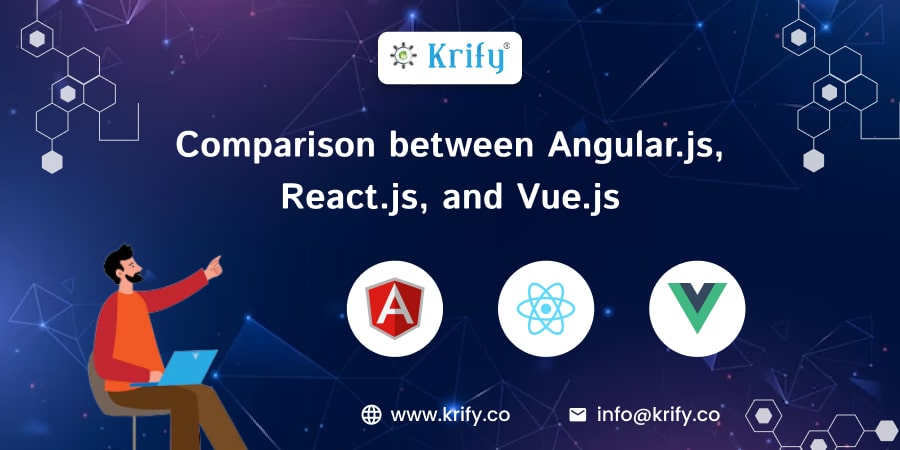In the ever-evolving web development landscape, choosing the right front-end framework can make a world of difference. With countless options, developers often find themselves at crossroads, between popular options like React.js, Angular.js, and Vue.js. Each framework brings its own set of benefits and trade-offs to the table and caters to different development needs and preferences. In this article, we will compare and contrast their characteristics, performance, ecosystem, and community support.
React.js: The Declarative Powerhouse
Developed by Facebook, React.js has gained wide popularity for its declarative and component-based approach to user interface design. With its virtual DOM and unidirectional data binding, React offers unparalleled performance and scalability. This makes it an ideal choice for large applications.
One of React’s unique features is its component-based architecture, which allows for reusability and maintenance. Developers can incorporate UI elements into their own components, making it easier to maintain complex user interfaces. Additionally, React JSX syntax allows developers to write HTML-like code in JavaScript, simplifying the development process and increasing code readability.
React’s vibrant ecosystem is another compelling reason for its widespread adoption. A rich collection of libraries and tools supports the framework, including Redux for state management, React Router for routing, and Jest for testing. Additionally, strong React community support ensures consistent updates, documentation, and third-party components, ultimately empowering developers to manage projects with confidence.
Angular.js: The Comprehensive Framework
Angular.js, hosted by Google, takes a more conceptual approach to front-end development, offering comprehensive solutions to build dynamic web applications. Through bilateral data binding and dependency injection, Angular delivers a comprehensive MVC (Model-View-Controller) architecture, enabling rapid development and easy integration with other frameworks and tools.
The main strength of Angular is its built-in features, which cover a wide range of development needs. Angular comes bundled with everything developers need to start their projects. It has everything from templating and routing to HTTP clients and form validation. Depending on the needs of the project and the preferences of the developer, this functionality can be a blessing and a curse.
Angular’s learning curve is often described as a drawback, especially for beginners or those making the transition from other programs. The complex terminology and concepts of the system, such as modules, tasks, and furnishings, pose challenges for newcomers. However once developers understand the concepts and conventions of Angular, they can harness its power to create robust and maintainable applications.
Vue.js: The Progressive Framework
Built by Evan Yu, Vue.js strikes a balance between simplicity and versatility. This makes it an attractive option for developers of all skill levels. Inspired by React’s component-based architecture and Angular’s data binding, Vue basically offers a practical way to build user interfaces that are responsive to the steep learning curve associated with other frameworks.
Vue’s unique feature is its growth adoption model allowing developers to incrementally integrate Vue into existing projects or use it as a standalone framework. This flexibility makes Vue a good choice for prototyping, building small applications, or gradual migration of legacy codebases to more modern architectures.
Vue’s slow learning and intuitive API have endeared it to developers looking for a hassle-free development experience. Furthermore, the framework’s documentation is concise and beginner-friendly. It has examples and clear explanations that guide developers through key concepts and best practices. Aditionally, Vue’s small size (only 20KB min+gzip) and minimal design is ideal for performance-conscious applications.
Comparative Analysis
When comparing React.js, Angular.js, and Vue.js, several factors come into play, including performance, developer experience, ecosystem, and community support. React excels in performance and scalability, thanks to its virtual DOM and component-based architecture. Angular offers a comprehensive solution with built-in features but with a steep learning curve. Vue strikes a balance between simplicity and versatility, offering a model of slow adoption and slow learning.
In terms of ecosystem and community support, React boasts a vibrant ecosystem with extensive third-party libraries and tools. Angular benefits from Google’s extensive support and documentation, while Vue’s thriving community and ecosystem offers plenty of resources for developers of all levels.
Conclusion
Ultimately, choosing between React.js, Angular.js, and Vue.js depends on the needs of the project, the skills of the development team, and personal preference. All in all, Developers should carefully evaluate the strengths and trade-offs of each framework to determine the best fit for their specific needs. Whether it’s the performance of React, the comprehensiveness of Angular, or the simplicity of Vue, each framework brings something different to the table in the battle for front-end frameworks.
We have a talented team of professionals who have great expertise in each of the frameworks. For more information, contact us.



